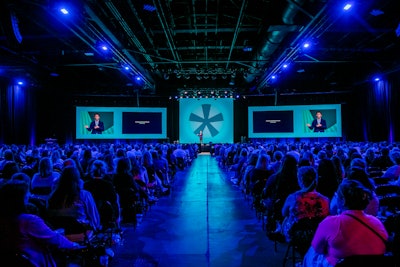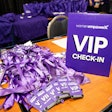
So, you've planned and executed a successful event, and gotten great feedback from your client. But then they ask those classic seven words: "How will we top it next year?" It's a good challenge to have! We chatted with five event professionals to learn when and how they decide to revamp an annual event.
1. Review attendee and client feedback.
“The first step toward making an event great is to assess the overall feedback and reactions from the previous event,” explains Kay Gowrinath, founder and managing director of Xquisite Productions in the U.K. “If the majority of clients and attendees were blown away by the format, decor, and programming, then I start considering whether to keep the winning formula or shake things up. If it's not broken, why fix it?”
Michael Kiss, an executive producer for St. Louis-based creative agency Switch, likes to lean into pre- and post-event surveys. “We have several clients that take attendee feedback seriously to adjust format or content,” he says. “Building your event around pre-event survey data and core initiatives is the foundation for a successful meeting. We also take the post-event client debrief seriously. Having that feedback from leadership or a planning team helps us build better events.”
Kiss continues, “Typically, we overhaul an event when it has been running with the same format every couple of years, and either there is a strategic direction change from leadership or feedback from attendees that drives a makeover. Each event should reflect and reinforce a distillation of initiatives and goals. If that process is not in place, it’s time to look under the hood.”
2. Take notes throughout the process, and debrief with your team.
To Rita Vass—head of events at Bitrise, which powers mobile app development for organizations like Duolingo, Equinox, and Tag Heuer—it’s important to have a series of post-event team meetings to run through each stage of the event, from ideation to execution.
The goal? "To identify gaps—not just from the actual event, but in our overall workflows leading up to it,” explains Vass, who oversees Bitrise’s annual Mobile DevOps Summit. “Then, we check for any negative patterns that we can proactively eliminate for future years. A big part of our process for identifying these gaps involves seeking feedback and input from our various stakeholders and industry experts for new ideas and/or issues that can signal areas for improvement.”
Meanwhile, Scott Schubert, the producer of Maker Faire Coney Island, likes to make notes throughout the planning and execution process, writing down things he doesn’t want to go through again, lessons learned, and more. “In the heat of the moment, it can be hard to take a step back and take a bird's-eye view of the entire event and process, but at some point—possibly after the event—it's important to do so,” he says.
Schubert also likes to debrief with everyone involved in the planning process. "Talk to the ticket sellers, talk to the people who answered emails, and the people who were working your information booth. Talk to security, vendors, etc.," he says. "Don't just focus on your piece of things—you will learn a lot of what worked well and what needs to be shed for next time.”
3. Carefully consider the pros and cons that would come with any changes.
After weighing feedback from attendees and other stakeholders, along with industry trends, budget, organization goals, and more, Vass likes to also weigh the potential risks and rewards of any major changes. "Ideally, all of our decisions are rooted in data-driven insights that we’ve gathered from previous events. This allows us to find a balance between keeping successful event elements and being able to constantly iterate and innovate based on the needs of both our organization and our audience,” she says.
4. Think through any components that worked particularly well.
Kelly Martinez, the host of the Scottsdale Permanent Makeup & Aesthetic Conference, tries to identify elements that consistently resonate with the audience, and use them as cornerstones for future years. She recently ran into this situation with a presenter who delivered a live demo that left the audience feeling particularly inspired and informed. “The success of this interactive session has fueled our excitement for next year's conference, where we're taking engagement to the next level,” she explains. “In 2024, we are planning to introduce an innovative and dynamic feature—an interactive live demo that encourages attendees to actively participate and learn in real time.”
To Vass, it’s all about enhancing those successful moments each year. “Content is key with a business-minded audience, so making sure that the content is relevant, up to date with the latest industry trends, and aligned with our target audience’s preferences is always at the forefront of our focus,” Vass notes as an example. “It’s equally important to understand your event’s session and speaker popularity from years past by getting feedback on specific topics and evaluating engagement and activity ratings. From there, we’re able to iteratively build on what already worked while keeping our company’s objectives top of mind.”
5. And think through what didn’t work as well—and how it can be improved.
“For identifying areas that didn't work, I rely on invaluable honest feedback from attendees, sponsors, and partners,” says Martinez, who likes to use post-event surveys. “If any component didn't align with our event objectives or garnered minimal engagement, it's a clear candidate for improvement.”
As an example from her own experience, Martinez says she once had vendors and presenters share the same space, something she thought would create a valuable synergy. “However, the reality turned out to be quite different,” she remembers. “We observed that this arrangement led to distractions for our attendees, as well as challenges for the vendors who wished to educate participants about their offerings. Recognizing the need for a more focused and efficient event, we made the strategic decision to separate the two aspects. This change not only streamlined the experience for attendees, but also allowed vendors to engage in more meaningful interactions with our guests, fostering a conducive environment for learning, networking, and business connections.”
6. Always keep the attendee experience at the forefront of any decisions.
For any changes you do make year to year, try to prioritize the ones that will improve the attendee experience. “This could involve selecting more captivating keynote speakers, refining session content, or introducing interactive sessions,” suggests Martinez. “By making targeted improvements, we maintain excitement while retaining the core essence of our event.”
Gowrinath also prioritizes areas that will have the most impact on the overall experience. “For example, if the programming was a hit, I might focus on enhancing the decor or incorporating interactive elements to keep things fresh. It's all about finding the areas that can make the biggest difference without overhauling the entire event,” he says.
7. Don’t forget the power of innovation.
Of course, just because your event gets good feedback doesn’t mean you should let it go stale. “My general advice is to inject novelty and surprise into the experience,” suggests Gowrinath. “People love to be wowed and caught off guard, so I always strive to introduce new elements each year. Whether it's a unique theme, a special guest, or an unexpected activity, these surprises keep both the team and attendees excited and engaged.”
Martinez also likes to prioritize innovation and engagement to ensure her events stay vibrant. “Regular updates to graphics, decor, and branding [can] play a crucial role in keeping the event visually engaging and avoiding any sense of monotony,” she notes as an example. “In preparation for next year's conference, we've taken the exciting step of rebranding our logo to reflect the evolving spirit of our event. … Maintaining a balance between the successful components and introducing new ideas is the key.”
8. Stay open to inspiration year-round.
“Throughout the entire year, keep your eyes and ears open for new experiences that can be incorporated into your event—new participants, new entertainment, new rides, new food/beverages, new speakers and guests,” advises Schubert. “Also, keep an eye on what is new out there in the world—go to other events, check them out, talk to their vendors, see what others are doing. It's important not to live in a bubble!”



















